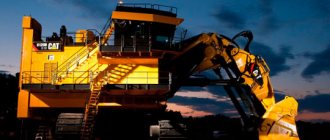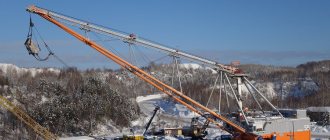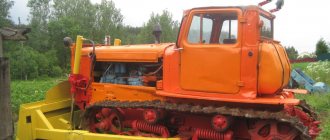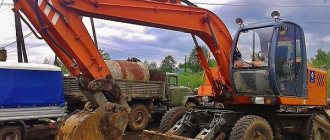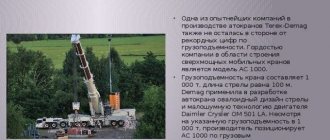Hitachi EX8000-6
A super-heavy model of a quarry, crawler excavator with a hydraulic drive, was manufactured in Japan in 2012, its purpose is the development and unloading of rock. With an operating weight of 811 tons and a rotation speed of the turntable of 3.3 rpm, the machine is capable of digging to a depth of 4 meters and unloading to a height of up to 14 m. Technical characteristics of the excavator:
- 2 diesel engines with a total power of 3000 hp;
- soil cutting force with a bucket – 2020 kN;
- created pressure on the ground – 236 kPa;
- a spacious rowing bucket with a straight shovel capacity of 40 m³, or a backhoe – 43 m³.
The largest mining excavators in the world
Most people today do not see anything unusual in such a useful mechanism in many areas of activity as an excavator, which can greatly facilitate the performance of labor-intensive operations, easily coping with both digging a simple hole and digging huge quarries.
Most of these cars, although they look massive and powerful, still do not cause much awe, unlike several models that we want to tell you about.
These huge beasts look like real titans among their brothers weighing hundreds of tons and are capable of bringing real horror to a person unprepared for such a spectacle with their terrifying dimensions, and specialists will be truly delighted with their impressive technical characteristics.
But even among record holders, a separate niche is occupied by the Bagger 288 excavator, which literally breaks all ideas about the maximum possible size of such equipment. This creation of German engineering was created by the Krupp corporation back in 1978 to work in the quarries of the Tagebau Hambach coal deposit. This giant weighs about 13.5 thousand tons, is 220 meters long and 96 meters high.

By the way, he even appeared in films, taking part in the films “The Hunger Games: Catching Fire” and “Ghost Rider: Spirit of Vengeance”.
The Bagger 288 uses a number of unique design solutions and, strictly speaking, it is not quite an excavator, but rather a rotary earthmoving machine, and then we will look at more familiar machines with a classic bucket and hydraulic mechanics.
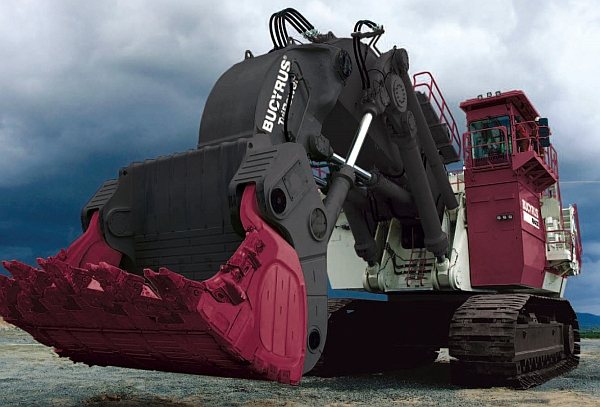
The first number on the top list is the Bucyrus RH400, weighing about 980 tons and carrying capacity up to 100 tons. Now it is owned by , and it was developed by order of the German Terex in 1997 and today is the largest hydraulic excavator on the planet.
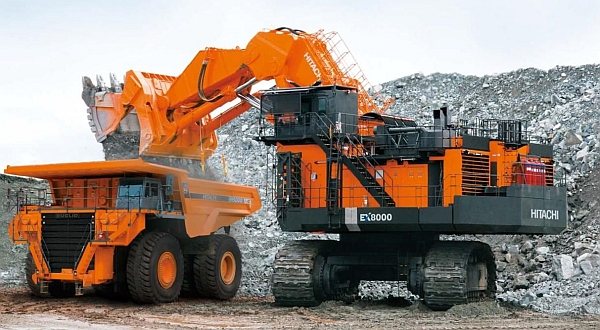
Next comes the Hitachi EX8000-6, weighing 811 tons, built by Hitachi Construction Machinery in 2012.

Third place belongs to the Liebherr R9800, which, with its weight of 810 tons, is literally breathing down the neck of its Japanese counterpart. Created in 2008 in Colmar, France.
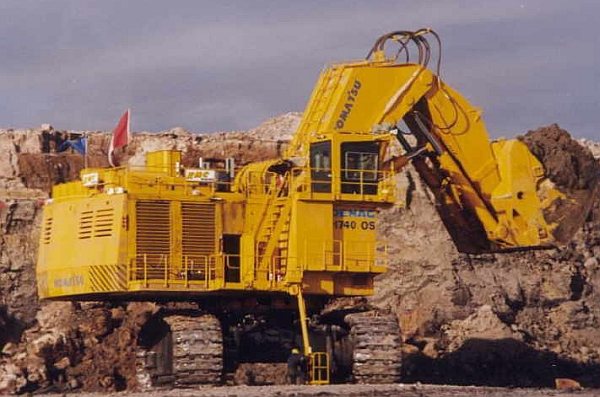
Launched in 199, the Demag H740 OS boasts a weight of approximately 744 tons and is designed for digging abrasive sands in Canadian oil fields.

The weight of the Komatsu PC8000-6 is 710 tons, and it occupies the fifth niche in the ranking of the largest hydraulic excavators.

On the sixth step we again see the brainchild of “Liebherr” with the index “R 996” and weighing 672 tons.
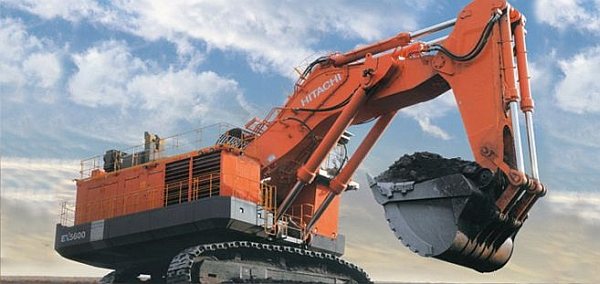
Well, Hitachi EX5600-6 closes the top seven mining giants with its modest figure of 537 tons. This model was created in 2012 on the basis of the EX5500-6 excavator.
Of course, all of the above models also differ in their simply insane price, but even this does not scare away potential buyers who really need such heavy-duty excavators. Well, if you choose something that is closer to everyday activities, then by looking at, say, the VolGus website, you can choose equipment according to your needs and financial capabilities, and the range is not limited only to earthmoving machines.
I hope you enjoyed reading here about these amazing machines, created by the work of thousands of specialists in various fields, especially since most people are unlikely to ever meet these giants in real life.
Big Muskie
Big Muskie was created in 1969 by an American company and continuously worked at a coal mine until 1991. The model is still considered the largest example of a “walking” dragline excavator. With a total weight of 13,000 tons and dimensions of 48 m/66 m/149 m (H/W/D), the vehicle had the following operating parameters:
- bucket volume/weight – 170 m³/210 tons;
- The lifting and walking mechanisms were powered by 2 electric motors with a total power of 1625 hp. With;
- boom length with flexible chain tie – 90 m.
The largest excavator
Mining and construction equipment, along with military installations, is one of the largest in the world. “Steel giants” as tall as a 25-story building, nicknamed excavators, daily move thousands of tons of overburden generated during coal mining. Germany has been most successful in developing “monsters” for the mining industry, since it was the German company Krupp that first built the largest excavator in the world. The Bagger 288, a 13,500 ton bucket wheel excavator manufactured in 1978, is still in service at the Rheinbraun coal mine.
The Krupp coal mining excavator, 240 meters long and 96 meters high, extracts more than 240 thousand cubic meters of rock every day. The Bagger 288 chassis consists of 12 tracks, each 3.8 meters wide. A bucket rotor with a diameter of 21.6 meters holds 18 small buckets with a volume of 6.6 cubic meters. meters each.

The rotary “288th” is driven by 16 electric motors, allowing it to reach a maximum speed of 0.6 kilometers per hour. In this case, the motors are powered through a special cable connected to an industrial power supply. The steel monster is controlled by only 4 people - the head of the team, the coordinator of the conveyor belts, who monitors the supply of coal to the belt, and two excavator operators, replacing each other during the work.

True, until 1995, the above excavator was considered the largest in the world. But after the construction of the “big brother” Bagger 293, the “288th” lost its status. In essence, the new model is an improved version of the bulky 288 Bagger. With a greater weight of 14.2 thousand tons, but a slightly shorter length of 225 meters, Bagger 293 produces coal in the same volumes as the previous model. The height of the rotary excavator remained the same - 96 meters, and the diameter of the rotary bucket also did not change. A photo of the largest excavator on the planet is presented below.
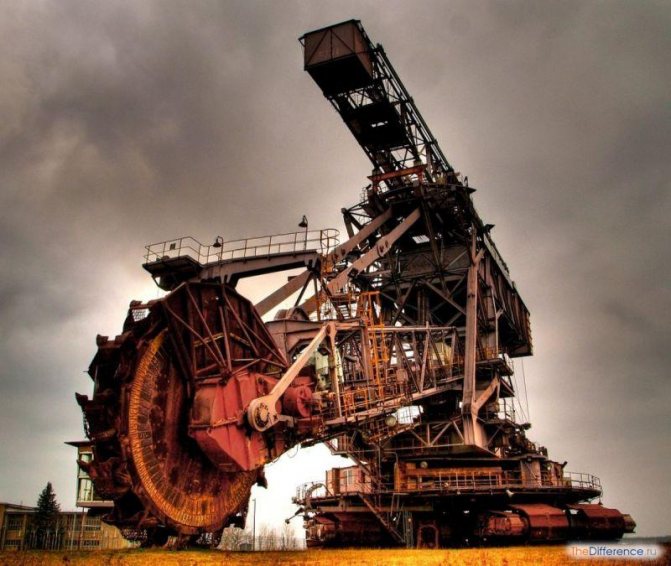
But in addition to rotary “steel monsters”, there are also single-bucket walking excavators, among which the “Big Mask” is considered the largest. The Big Muskie 4250W dragline began operation in 1969. The length of the dragline was 148 meters and the height was almost 68 meters. An excavator weighing 13 thousand tons, created by Bucyrus Erie, worked at a coal mine in the American state of Ohio for more than 30 years. During this time, Big Muskie shoveled more than 460 million tons of overburden and mined about 20 million tons of coal.
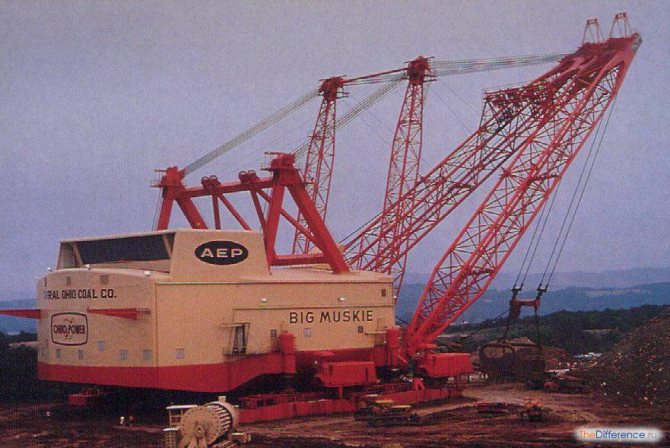
Like Krupp's Baggers, the Big Muskie's mechanisms were driven by electric motors powered by a 13,800-volt cable. Alas, in 1999 its service life expired and the Big Muskie was dismantled. Excavator bucket with a capacity of 168 cubic meters. meters, accommodating two buses, is stored in the mining museum in Morgan County. During his entire career, Big Mask walked only a few kilometers in his “20-meter shoes.”

Due to the fact that coal production volumes are increasing every year, it can be assumed that a new record holder will soon appear in the mining segment. An interesting video about the world's largest excavator Bagger 288 is presented below:
Komatsu, PC8000-6
The model of the hydraulic, crawler excavator R S 8000 is considered one of the largest in the line of Japanese earth-moving equipment. The machine is used in the metallurgical and mining industries, its operating parameters:
- power – 4200 hp;
- bucket volume – 36 m³;
- rotation speed of the working platform – 3.5 rpm;
- max depth of digging/cutting soil – 8.5 m;
- max lifting height of the bucket – 16 m;
- the running chassis consists of 2 side (body) tracks and one central track;
- operating weight – 720 tons.
Bagger 293
The world's largest rotary, self-propelled, mining excavator, Bagger 293, was developed by the German company Takraf in 1995. Its design is designed for continuous work on digging heavy soils using several buckets rotating on a rotary wheel. Today this mega machine operates in Germany, digging brown coal in open pits. Excavator characteristics:
- daily productivity – 230 m³ of rock;
- rotor wheel diameter – 22.6 m;
- the number of buckets on the wheel is 18 pcs, the productivity of each bucket is 15 m³;
- total vehicle weight – 14200 tons;
- length – 228 m;
- 5 operators are required for maintenance.
Terex RH 400
The largest tracked mining excavator, the Terex RH 400, was manufactured in Wisconsin (USA) and then assembled in Africa for the construction of the Mokopana Dam. Today, such a machine operates in Canada in the extraction of oil-saturated sand, and in Africa in ore deposits. Features of RH 400:
- it is equipped with two 16-cylinder engines, each with a power of 4400 hp. With;
- a bucket with a volume of 45 m³ is capable of scooping up 100 tons of mined rock/soil at a time;
- the telescopic handle of the bucket can extend up to 19 m and provide the bucket, when it comes into contact with the rock being removed, with an impact force of 340 tons;
- can dig to a depth of 2.4 m;
- rotation speed of the working element during loading – 4.5 rpm;
- the operating weight of the machine is 980 tons.
If you want to read about tractor manufacturers, follow the link Tractor Manufacturers.
crawler, large hydraulic, quarry, rotary and walking
Excavator is a general name for earth-moving machines that are equipped with a bucket. There are several dozen modifications of these mechanized devices.
They differ from each other in the method of operation (universal construction, mine, trench, single-bucket), in the type of undercarriage used (walking, tracked, wheeled, etc.), in purpose, in design and, of course, in size.
An example of a wheeled excavator is EO 2621.
Excavators are used in construction (including road construction), in quarries, and in mine workings . A feature of this type of earthmoving machines is that the bucket (working body) moves independently of the chassis.
In addition to excavators, dump trucks also work in quarries, for example, the largest mining dump truck - BelAZ 75710.
Leonardo da Vinci is considered to be the inventor of the excavator, who created a general drawing and schematic diagram of a machine similar to a modern dragline excavator. The first working excavator was developed by Smith Otis, an American mechanic, in the mid-30s of the nineteenth century.
An example of a modern backhoe loader is the JBC 3CX.
The largest excavators
Rotary
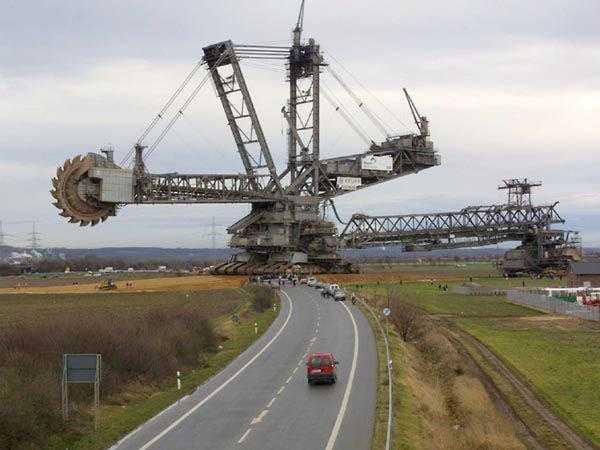
The largest rotary excavator in the world (until 1995), used in the coal industry - Bagger 288 (Germany). Its length is 240 m, its width is 46, and the height of this giant is 96 meters. Weight – 13,500,000 kg. The excavator rotor has a diameter of 22 meters and makes 48 revolutions per minute. you can see it in the photo above.
The number of buckets is 18, the volume of each of them is 6.6 cubic meters. meters. This unit is equipped with 16 electric motors with a total power of 560 kW. To operate, it needs as much energy as would be enough for the needs of a medium-sized village - 16.5 megawatts. In 24 hours it produces about 240,000 cubic meters of coal.
Bagger is served by 4 people. There is a kitchen and bathroom on board. Bagger 288 is a crawler excavator, its speed is no more than 600 m/h. The tracks have twelve supports, which makes it possible not to push the ground too much when moving. This colossus was created by the famous company Krupp.
More detailed information is given in the video:
The car costs about one hundred million dollars.
But in 1995, the German company TAKRAF built another Bagger, already number 293 . It weighs more than 14,000,000 kg. Although its dimensions are slightly smaller (the length is 227 meters and the height of the machine is 94 meters), according to the Guinness Book, it is the largest mining excavator in the world.
Productivity – 10,000 cubic meters per hour. The car is serviced by a team of five people. The rotor diameter of Bagger 293 is 21 meters. This excavator took five years to build. The cost is more than one hundred million dollars.
Walking
The largest walking excavator in the world is the American Big Muskie 4250W . It was assembled right in a coal mine by order of the Central Ohio Coal's company. Its dimensions (length-width-height) are 148.6x46.2x67.8 m. It weighed 13,000,000 kg. Big Muskie is a single-bucket unit with a bucket capacity of 168 cubic meters. meters.
It took two years to build (from 1967 to 1969), and it worked for 30 years, after which it was dismantled. During its working life, this machine produced 460,000,000 cubic meters of coal. Its production cost $25 million.
Hydraulic
German hydraulic Terex Rh500
The German Terex model RH 400 was also assembled directly at the site of the upcoming work. The assembly was completed in two weeks. It was used to build a dam in Africa. Weight – 980,000 kg, bucket volume – 50 cubic meters. meters. The fuel tank of this giant holds 15,000 liters. The Terex RH 400 is capable of lifting 100,000 kg.
Equipped with two Cummins engines with a capacity of 2300 hp. With. every. The largest hydraulic excavator in the world costs $14 million.
The largest Russian mining excavator
ECG-32R was released in 2009 . She built it. It is considered the largest unit equipped with a mechanical straight shovel. Excavator weight – 1,000,000 kg. The bucket volume is 32 cubic meters, the EKG-32R can load up to 30,000 cubic meters. meters of rock per day. Equipped with a modernized electric drive.
For comparison, read about Russian mini excavators.
Rating of crawler excavators
Large rotary quarry excavators are usually created in a single copy and work in one place. Among the crawler excavators produced in small batches, there are also giants :
- Bucyrus Rh500 . The first model was produced in 1997. Manufacturer: Caterpillar (see here). Equipped with an engine (16 cylinders) with a capacity of 4400 hp. With. Weight – 889,000 kg. Bucket volume – 45 cubic meters. A very large crawler excavator, the tracks are 11 meters long.
2. Hitachi EX8000-6 . Released in 2012. The height of the machine is 10 meters. Weight – 811,000 kg. The width of the bucket is 8.65 meters, the volume is 45 cubic meters. The excavator is equipped with two diesel engines (16 cylinders), the combined power of which is 3880 hp. With. The first unit of this modification was used for coal mining in Australia.
3. Liebherr R9800 . Year of manufacture – 2008. The bucket has a volume of 45 cubic meters. Excavator weight – 800,000 kg, power – 3280 hp. With.
4. Demag H740 OS . It was created in 1999 to work in Canada, on sandy soils. Bucket volume – 40 cubic meters, power – 4000 liters. With.
5. Komatsu PC8000-6. Japanese car weighing 710,000 kg and 8 meters high. The Komatsu bucket holds 38 cubic meters of rock. Power reaches 4000 hp. With.
6. Liebherr R 996 . Height – 8 meters, weight – 676,000 kg. The length of the bucket is 10 meters, the volume is 36 cubic meters. Engine power – 3000 l. With.
7. Hitachi EX5600-6 . Production of these excavators began in 2012. Equipped with an EX5600-6 engine, power – 3000 hp. With. Weighs 573,000 kg, bucket volume is 29 cubic meters.
8. Komatsu PC5500-6 . Earth-moving machine with two engines, weighing 500,000 kg. Total power – 2520 hp. With. Bucket capacity is 29 cubic meters.
8. Hitachi EX5500-6 . The height of this model is just over 9 meters. Year of manufacture – 2009. Bucket volume – 27 cubic meters. The Hitachi EX5500-6 weighs 522,000 kg.
9. Bucyrus RH 340/RH 340-B . 498-ton unit with two engines, 1500 hp. With. every. The bucket can hold 34 cubic meters of rock.
In addition to giant excavators, our website also contains information about other large equipment. This article, for example, is devoted to the ranking of the largest dump trucks in the world.
The rating also includes the Belaz excavator. A description of this manufacturer can be found here.
MAZ also produced gigantic equipment. You can find out about the Maz-541 airfield tractor here.
Despite the fact that nanotechnology is actively developing, the creation of miniature earth-moving machines is unlikely to be realized in the near future. Therefore, it is quite possible that an excavator will appear that will be larger in size than the existing ones.
On our website you will find descriptions of not only giant excavators. Check out Hyundai's tracked and wheeled excavators in this article.
We also bring to your attention the largest bulldozers in the world and the largest truck cranes in the world.
machinspec.com
